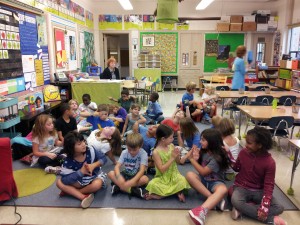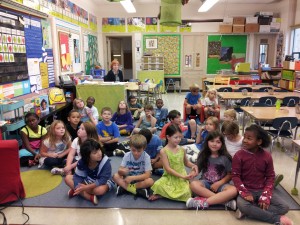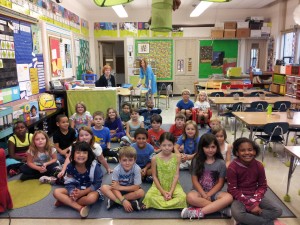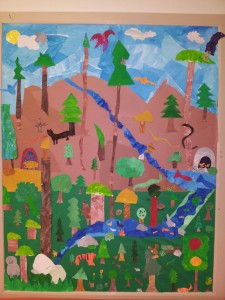Forest Mural:
We worked together to create this beautiful mural. It serves as a visual representation of our classroom. We read a few forest books, which described how the many different parts of a forest work together. The trees, animals and plants are great individually, but together they create something amazing. All of the students in the class are unique and important by themselves, but together we are an amazing community of learners!
It took several steps to get to this end product. We started by making painted paper. We focused on blending a variety of shades and creating texture with color and brush strokes. The following week we created a huge list of all the things we would find in forests. (We didn’t try to make a specific type of forest though!) Finally, we used scissors and glue to create the individual pieces. Each student had to make at least one tree and then they could make the other things – water, animals, plants, clouds, etc. I worked on stapling up the pieces as fast as I could so that they could see the forest being created as they worked.
Whole Body Listening:
Our Superflex lesson this week was about “Whole Body” Listening. We read a book called Listening Larry and discussed the difference between listening and hearing. Hearing is passive – I told them that they might hear my voice but all it sounds like is “blah, blah, blah!” Listening is active – you have to be engaged in what is going on. It is also a two-way interaction. The listener demonstrates to the speaker that they are listening and the speaker feels respected and heard. Ask your child if they can explain and demonstrate Whole Body Listening! We will be practicing this important skill all year.

Don’t worry…this is a posed picture. I asked the kids to show an example of “not listening.” Of course, things like this happen, but what kids (and adults) have trouble with is often more subtle.

Also a staged picture! I asked the kids to pretend to listen. Notice the staring into space, looking in the wrong direction and looking at the ground. These are the more subtle ways that we don’t listen. We are working on learning to actively listen all the time. I want students to have strategies to help themselves listen when they realize they are struggling to listen. We all struggle with this at times! 🙂

This is an excellent example of what Whole Body Listening looks like! Notice the kids sitting up, facing the speaker and making eye contact! Here are the parts of whole body listening:
- Eyes – Look at the speaker
- Ears – Hear what is being said
- Mouth – Is quiet
- Hands – Are still. Small wiggles are fine as long as they don’t distract other listeners or the speaker.
- Feet – Are still. Same rule as above for wiggles.
- Body – Shoulders are facing the speaker.
- Brain – Is thinking about what is being said.
- Heart – Cares about what is being said and/or the speaker.

